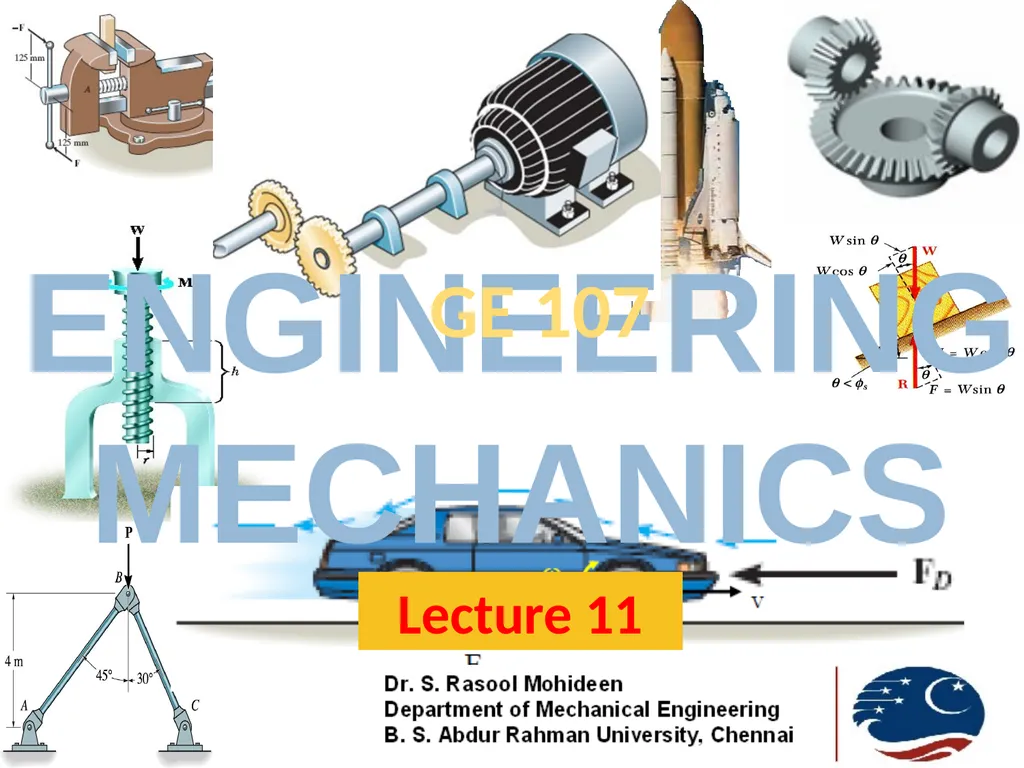1 ENGINEERING MECHANICS GE 107 Lecture 11 Unit IV
Author : luanne-stotts | Published Date : 2025-05-12
Description: 1 ENGINEERING MECHANICS GE 107 Lecture 11 Unit IV Dynamics Of Particles Review of laws of motion Newtons law Work Energy Equation of particles Impulse and Momentum Impact of elastic bodies Introduction to vibrations Single
Presentation Embed Code
Download Presentation
Download
Presentation The PPT/PDF document
"1 ENGINEERING MECHANICS GE 107 Lecture 11 Unit IV" is the property of its rightful owner.
Permission is granted to download and print the materials on this website for personal, non-commercial use only,
and to display it on your personal computer provided you do not modify the materials and that you retain all
copyright notices contained in the materials. By downloading content from our website, you accept the terms of
this agreement.
Transcript:1 ENGINEERING MECHANICS GE 107 Lecture 11 Unit IV:
1 ENGINEERING MECHANICS GE 107 Lecture 11 Unit IV Dynamics Of Particles Review of laws of motion – Newton’s law – Work Energy Equation of particles – Impulse and Momentum – Impact of elastic bodies. Introduction to vibrations - Single degree of freedom systems – with and without damping 2 Impulse and Momentum A third basic method for the solution of problems dealing with the motion of particles is based on the principle of impulse and momentum This can be used to solve problems involving force, mass, velocity, and time. It is of particular interest in the solution of problems involving impulsive motion and problems involving impact 3 This impact test between an F-4 Phantom and a rigid reinforced target was to determine the impact force as a function of time Impulse and Momentum (Contd.) Consider a particle of mass m acted upon by a force F. As seen earlier, Newton’s second law can be expressed in the form where mv is the linear momentum of the particle. Multiplying both sides by dt and integrating from a time t1 to a time t2 , we get Transposing the last term, The integral term is a vector known as the linear impulse, or simply the impulse, of the force F during the interval of time considered. 4 Impulse and Momentum (Contd.) The above equation expresses that when a particle is acted upon by a force F during a given time interval, the final momentum mv2 of the particle can be obtained by adding vectorially its initial momentum mv1 and the impulse of the force F during the time interval considered It can be written as When several forces act on a particle, the impulse of each of the forces must be considered. When a problem involves two particles or more, each particle can be considered separately and the above equation can be written for each particle. We can also add vectorially the momenta of all the particles and the impulses of all the forces involved as 5 Impulse and Momentum (Contd.) If no external force is exerted on the particles or, if the sum of the external forces is zero, the second term in the equation vanishes and reduced to A force acting on a particle during a very short time interval that is large enough to produce a definite change in momentum is called an impulsive force and the resulting














